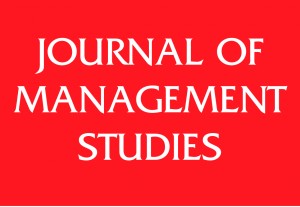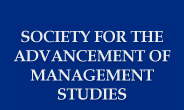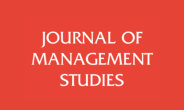
Call for Papers for a Special Issue
ORGANIZATIONAL STIGMA:
ANTECEDENTS, PROCESSES, AND CONSEQUENCES
Submission Deadline: 2nd December 2019
Submissions to: business.jms@durham.ac.uk
Guest Editors:
Bryant A. Hudson (IESEG, France)
Kimberly D. Elsbach (University of California Davis, USA)
Wesley S. Helms (Brock University, Canada)
Karen D. W. Patterson (University of New Mexico, USA)
Thomas J. Roulet (University of Cambridge, UK)
JMS Editor:
Daniel Muzio (University of York, UK)
Background
Organizations and those that engage them are evaluated by a range of diverse audiences and can be stigmatized by them to varying degrees. This special issue seeks to address and invite authors to contribute to the still emergent but growing literature on organizational stigma, including fields, industries, or a single stigmatized organization. We are interested in various levels of analysis, whether organizational, industry, field, or the micro- or meso-level antecedents and consequences of organizational stigma. We also hope to extend this stream of work by addressing the multi- and cross-level processes of stigmatization, stigma transfer, and their implications for organizations.
Historically, definitions of stigma at the organizational level are inspired from the extensive work at the individual level (Link & Phelan, 2001). While individual-level stigma has received a great deal of attention (for a recent review, see Pescolido & Martin, 2015) organizational stigma, defined as “a label that evokes a collective stakeholder group-specific perception that an organization possesses a fundamental, deep-seated flaw that deindividuates and discredits the organization” (Devers et al. 2009), is garnering greater attention. This type of stigma occurs at both the organization (Hudson, 2008; Hudson, 2016) and at the industry or field levels of analysis (Galvin et al. 2004; Vergne, 2012). First applied at the organizational level by Hughes (1984) and Sutton and colleagues (Elsbach & Sutton, 1992; Sutton & Callahan, 1987), a stream of stigma centered research has proceeded on tainted occupations (Ashforth & Kreiner, 1999); the transfer of stigma from failed organizations to managers (Sutton & Callahan, 1987) and other stakeholders (Vergne, 2012).
Multilevel and cross-level, i.e., stigma that affects or is transferred across organizational members (Hudson & Okhuysen, 2009), groups and teams, and upper echelons, has received scant attention to date (Paetzold et al. 2008). At the individual level, recent work on individual level stigma has looked at the management of concealable stigma (Jones & King, 2014; Stenger & Roulet, 2018) and the temporality of stigmatization, but those questions have not been explored for meso- and macro-stigma, which may take very different forms for organizations or fields. While scholars have begun to examine some of these and related processes, several problems substantially limit our ability to study organizational and cross level stigma and to build a body of knowledge about it.
Existing work is grounded in different theoretical assumptions of regarding organizations and actors including categories (Vergne, 2012), framing (Carberry & King, 2012), identity (Tracey & Philips, 2016) as well as institutional (Roulet, 2015; Hampel & Tracey, 2016). Across those different theoretical lenses, it has been shown that organizational stigma has a range of adverse and contrary consequences such as stakeholder disengagement (Durand & Vergne, 2014; Piazza & Perretti, 2015), identity clashes (Tracey & Phillips, 2016) or tainted employees (Sutton & Callahan, 1987). While some studies focus on de-stigmatization processes (Hampel & Tracey, 2016), and others examine stigma that is unavoidable (e.g., Hudson & Okhuysen, 2009), stigma and stigmatization as a benefit or how it might be embraced has also received scant attention, though some work has explored the benefits of stigma (Helms & Patterson, 2014). Embracing stigma however remains to be explored from the perspective of audiences that support or interact with the stigmatized organization.
Aims and Scope
We believe that the lack of theory on how stigma and stigmatization emerges, spreads, and shapes organizational contexts of theory on how stigma functions in contexts is due to three challenges persistent in the literature:
- Overlapping definitional and conceptual problems that obstruct our ability to understand what organizational stigma is and is not.
- A lack of a general understanding of the multi- and cross-level antecedents of organizational stigma, their qualities, and those processes.
- The consequences of these conceptual and empirical challenges in limiting the potential application and implications of stigma as a theoretical construct to broader organizational contexts and theories.
We hope to publish a set of papers contributing to the organizational stigma literature addressing those three issues. We hope to develop new frameworks to understand organizational stigma that deliver an agenda for future study and for addressing a diverse set of issues that include, but are not limited to:
- How can organizational stigma be characterized? What are the dimensions of organizational stigma? How does organizational stigma differ from one case to another? How does the concept of organizational stigma differ from other negative social evaluations (Mishina & Devers, 2011)?
- The sources of organizational stigma: why and how does stigma emerge? What causes stigma and what role is played by audiences? (Roulet, 2015) How does misconduct, deviance, and scandal lead to organizational stigma?
- Responses to stigmatization: how can organizations manage and react to different types of stigma? How do stakeholders of the organization respond to stigmatization? How can organizational contexts lead to stigmatization?
- Understanding and exploring the experience of being a stigmatized individual organization: How can we better conceptualize the stigmatized solo actor? What are the dynamics of stigmatization and stigma management for solo organizations (Hampel & Tracey, 2017)?
- Stigma transfer and courtesy stigma (Hudson & Okhuysen, 2009): how is stigma transferred to other organizations, stakeholders and society, as well as to individuals?
- Multi-level and cross-level issues in stigma theory: How does organizational stigma affect individuals and employees? How do stigmatized employees affect the evaluation of their organization?
- Given the rich and expansive literature on stigma at the individual level, what insights can be drawn from this literature for organization level and cross-level stigma processes and responses.
- What are the relationships and differences between stigma at the individual level and the organizational level of analysis? How are stigma and stigmatization multi-level and cross-level of analysis phenomena and processes?
- How can the literature on deviance at multiple levels of analysis (Warren, 2003) inform our understanding of stigma?
- Can organizations be more or less stigmatized within contested industries? (Vergne, 2012).
- The positive implications of stigmatization (Helms & Patterson, 2014).
Submission Process and Deadlines
The deadline for submissions is 2nd December 2019.
Submissions should be prepared using the JMS Manuscript Preparation Guidelines (http://www.socadms.org.uk/wp-content/uploads/JMSManuscript-Preparation-Guidelines.pdf).
Manuscripts should be submitted by e-mail to Margaret Turner at business.jms@durham.ac.uk
Papers will be reviewed according to the JMS double-blind review process.
Informal enquiries relating to the Special Issue, proposed topics and potential fit with the Special Issue objectives are welcomed. Please direct any questions to the Guest Editors on the following email address: JMS.stigma@gmail.com
Special conference and manuscript development workshop:
The guest editors of this Special Issue are planning to hold a special conference and manuscript development workshop in Paris in the Fall of 2019 before the submission deadline.
Please note that participation in the workshop does not guarantee acceptance of the paper in the Special Issue. Furthermore, attendance is also not a prerequisite for submission to the special issue or publication.
References
Ashforth, B. E. and Kreiner, G. E. (1999). ‘“How can you do it?”: Dirty work and the challenge of constructing a positive identity’. Academy of Management Review, 24, 413-34.
Carberry, E. J. and King, B. G. (2012). ‘Defensive Practice Adoption in the Face of
Organizational Stigma: Impression Management and the Diffusion of Stock Option Expensing’. Journal of Management Studies, 49, 1137-67.
Devers, C. E., Dewett, T., Mishina, Y. and Belsito, C. A. (2009). ‘A General Theory of Organizational Stigma’. Organization Science, 20, 154-71.
Durand, R. and Vergne, J.-P. (2014). ‘Asset Divestment as a Response to Media Attacks in Stigmatized Industries’. Strategic Management Journal, 36, 1205-23.
Elsbach, K. D. and Sutton, R. I. (1992). ‘Acquiring organizational legitimacy through illegitimate actions: A marriage of institutional and impression management theories’. Academy of Management Journal, 35, 699-738.
Galvin, T. L., Ventresca, M. J. and Hudson, B. A. (2004). ‘Contested industry dynamics’. International Studies of Management & Organization, 34, 56-82.
Goffman, E. (1963). Stigma: Notes on the Management of Spoiled Identity. Englewood Cliffs, NJ: Prentice-Hall.
Hampel, C. E. and Tracey, P. (2016). ‘How Organizations Move From Stigma to Legitimacy: The Case of Cook’s Travel Agency in Victorian Britain’. Academy of Management Journal, 60, 2175-207.
Helms, W. S. and Patterson, K. D. (2014). ‘Eliciting acceptance for “illicit” organizations: The positive implications of stigma for MMA organizations’. Academy of Management Journal, 57, 1453-84.
Hudson, B. A. (2008). ‘Against all odds: A consideration of core-stigmatized organizations’. Academy of Management Review, 33, 252-66.
Hudson, B. A. and Okhuysen, G. A. (2009). ‘Not with a Ten-Foot Pole: Core Stigma, Stigma Transfer, and Improbable Persistence of Men’s Bathhouses’. Organization Science, 20, 134-53.
Hudson, B. A. (2016). ‘Organizational Stigma’. In Carroll, C. E. (Ed.), SAGE Encyclopedia of Corporate Reputation. Thousand Oaks, CA: SAGE Publications Inc., 808-10.
Hughes, E. C. (1984). Bastard Institutions, The Sociological Eye: Selected Papers. New Brunswick, NJ: Transaction Books.
Jones, K. P. and King, E. B. (2014). ‘Managing concealable stigmas at work: A review and multilevel model’. Journal of Management, 40, 1466-94.
Link, B. G. and Phelan, J. C. (2001). ‘Conceptualizing Stigma’. Annual Review of Sociology, 27, 363-85.
Mishina, Y. and Devers, C. E. (2011). ‘On being bad: Why stigma is not the same as a bad reputation’. In Pollock T. G and Barnett, M. L (Eds). The Oxford Handbook of Corporate Reputation. Oxford: Oxford University Press, 201-20.
Paetzold, R. L., Dipboye, R. L. and Elsbach, K. D. (2008). ‘A new look at stigmatization in and of organizations’. Academy of Management Review, 33, 186-93.
Pescolido, B. A. and Martin, J. K. (2015). ‘The stigma complex’. Annual Review of Sociology, 41, 87-116.
Piazza, A. and Perretti, F. (2015). ‘Categorical Stigma and Firm Disengagement: Nuclear Power Generation in the United States, 1970–2000’. Organization Science, 26, 724-42.
Roulet, T. (2015). ‘“What Good is Wall Street?” Institutional Contradiction and the Diffusion of the Stigma over the Finance Industry’. Journal of Business Ethics, 130(2), 1-14.
Slade Shantz, A., Fischer, E., Liu, A. and Lévesque, M. (2018). ‘Spoils from the Spoiled: Strategies for Entering Stigmatized Markets’. Journal of Management Studies, forthcoming.
Stenger, S. and Roulet, T. J. (2018). ‘Pride against prejudice? The stakes of concealment and disclosure of a stigmatized identity for gay and lesbian auditors’. Work, employment and society, 32, 257-73.
Sutton, R. I. and Callahan, A. L. (1987). ‘The stigma of bankruptcy: Spoiled organizational image and its management’. Academy of Management Journal, 30, 405-36.
Tracey, P. and Phillips, N. (2016). ‘Managing the Consequences of Organizational Stigmatization: Identity Work in a Social Enterprise’. Academy of Management Journal, 59, 740-65.
Vergne, J.-P. (2012). ‘Stigmatized categories and public disapproval of organizations: A mixed-methods study of the global arms industry, 1996–2007’. Academy of Management Journal, 55, 1027-52.
Warren, D. E. (2003). ‘Constructive and destructive deviance in organizations’. Academy of management Review, 28, 622-32.
Zavyalova, A., Pfarrer, M. and Reger, R. (2016). ‘Celebrity and infamy? The consequences of media narratives about organizational identity’. Academy of Management Review, 42, 461-80.

